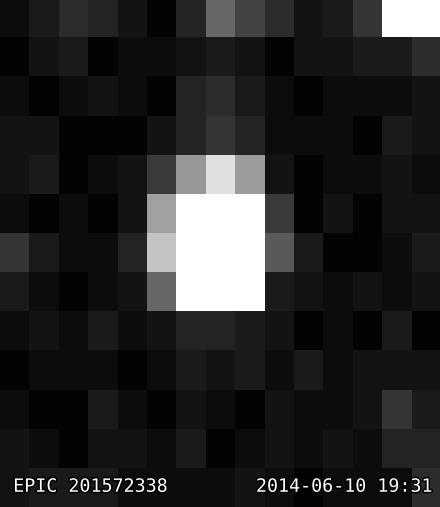Create beautiful quicklook movies from the pixel data observed by NASA's Kepler spacecraft.
Project description
Create quicklook movies from the pixels observed by NASA’s Kepler/K2/TESS spacecraft.





K2flix makes it easy to inspect the CCD pixel data obtained by NASA’s Kepler and TESS space telescopes.
The need for this tool arises from the fact that all telescope data is affected by sources of noise such as pointing jitter and foreground asteroids, which are often more easily spotted by eye than by algorithm.
This tool takes Kepler’s or TESS’s Target Pixel Files (TPF) as input and turns them into contrast-stretched animated gifs or MPEG-4 movies. These TPF files are publically available from the Kepler archive, the K2 archive, or TESS simulations.
K2flix can be used both as a command-line tool or using its Python API.
Example
Asteroids commonly pass in front of Kepler/K2 targets. We can use k2flix to create a two-day animation of pixel data to view the asteroids whizzing past:
$ k2flix --start 545 --stop 680 --step 1 --fps 12 --stretch linear --ut http://archive.stsci.edu\ /missions/k2/target_pixel_files/c1/201500000/72000/ktwo201572338-c01_lpd-targ.fits.gz

To see many more examples, follow @KeplerBot on Twitter!
Installation
If you have a working installation of Python on your system, you can install k2flix using pip:
$ pip install k2flix
Alternatively, you can get the latest version by installing from source:
$ git clone https://github.com/barentsen/k2flix.git $ cd k2flix $ python setup.py install
Using k2flix
After installation, the k2flix tool will be available on the command line. You can then use it as follows.
To convert a Kepler pixel file to an animated gif:
$ k2flix tpf-file.fits.gz
To convert a Kepler pixel file to an MPEG-4 movie:
$ k2flix --o movie.mp4 tpf-file.fits.gz
K2flix supports reading from web URLs, so you can generate a movie directly from the data archive:
$ k2flix https://archive.stsci.edu/missions/k2/target_pixel_files/c1/201400000/00000/ktwo201400022-c01_lpd-targ.fits.gz
To see all the options, use the –help argument to see the full usage information:
$ k2flix --help
usage: k2flix [-h] [-v] [--output FILENAME] [--start START] [--stop STOP]
[--step STEP] [--fps FPS] [--binning BINNING] [--dpi DPI]
[--stretch STRETCH] [--min_cut MIN_CUT] [--max_cut MAX_CUT]
[--min_percent %] [--max_percent %] [--cmap CMAP] [--flags]
[--raw | --background | --cosmic]
[--ut | --jd | --mjd | --bkjd | --cadence]
tpf_filename [tpf_filename ...]
Converts a Target Pixel File (TPF) from NASA's Kepler/K2/TESS spacecraft into
an animated gif or MPEG-4 movie for human inspection.
positional arguments:
tpf_filename path to one or more Target Pixel Files (TPF)
optional arguments:
-h, --help show this help message and exit
-v, --verbose
--output FILENAME .gif or .mp4 output filename (default: gif with the same
name as the input file)
--start START first frame to show. Give the frame number (default 0),
or a Julian Day if --jd/--mjd/--bkjd is set, or a cadence
number if --cadence is set.
--stop STOP final frame to show. Give the frame number (default: -1),
or a Julian Day if --jd/--mjd/--bkjd is set, or a cadence
number if --cadence is set.
--step STEP spacing between frames (default: show 100 frames)
--fps FPS frames per second (default: 15)
--binning BINNING number of cadence to co-add per frame (default: 1)
--dpi DPI resolution of the output in dots per K2 pixel (default:
choose a dpi that produces a 440px-wide image)
--stretch STRETCH type of contrast stretching: "linear", "sqrt", "power",
"log", or "asinh" (default is "log")
--min_cut MIN_CUT minimum cut level (default: use min_percent)
--max_cut MAX_CUT maximum cut level (default: use max_percent)
--min_percent % minimum cut percentile (default: 1.0)
--max_percent % maximum cut percentile (default: 95)
--cmap CMAP matplotlib color map name (default: gray)
--flags show the quality flags
--raw show the uncalibrated pixel counts ('RAW_CNTS')
--background show the background flux ('FLUX_BKG')
--cosmic show the cosmic rays ('COSMIC_RAYS')
--ut use Universal Time for annotation (default)
--jd use Julian Day for annotation and --start/--stop
--mjd use Modified Julian Day for annotation and --start/--stop
--bkjd use Kepler Julian Day for annotation and --start/--stop
--cadence use Cadence Number for annotation and --start/--stop
Citing
This tool was created by Geert Barentsen at NASA’s Kepler/K2 Guest Observer Office. If this tool aided your research, please include a citation. The code has been registered in the Astrophysics Source Code Library [ascl:1503.001] and the preferred BibTeX entry is:
@MISC{2015ascl.soft03001B,
author = {{Barentsen}, G.},
title = "{K2flix: Kepler pixel data visualizer}",
howpublished = {Astrophysics Source Code Library},
year = 2015,
month = mar,
archivePrefix = "ascl",
eprint = {1503.001},
adsurl = {http://adsabs.harvard.edu/abs/2015ascl.soft03001B},
adsnote = {Provided by the SAO/NASA Astrophysics Data System},
doi = {10.5281/zenodo.15576},
url = {http://dx.doi.org/10.5281/zenodo.15576}
}
Contributing
To report bugs and request features, please use the issue tracker. Code contributions are very welcome.
License
Copyright 2016 Geert Barentsen. K2flix is free software made available under the MIT License. For details see the LICENSE file.
Project details
Release history Release notifications | RSS feed
Download files
Download the file for your platform. If you're not sure which to choose, learn more about installing packages.











